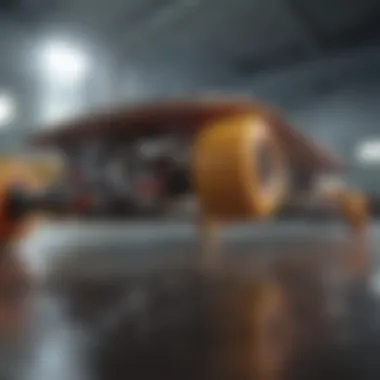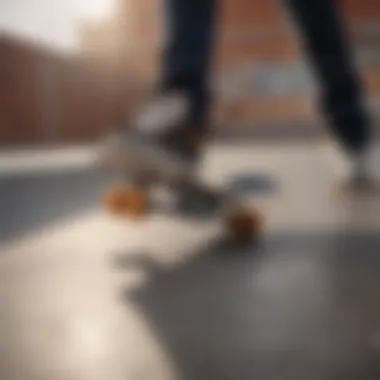Exploring Long Skateboard Trucks: Dynamics & Design


Intro
Long skateboard trucks play a crucial role in shaping the experience of skaters worldwide. When it comes to skateboarding, the right equipment can significantly influence performance and rider comfort. Among these components, skateboard trucks are essential for stability during tricks and turns. Choosing long skateboard trucks can elevate a skater's skills and make riding smoother, especially on varied terrain. This article will traverse the significance of these trucks, analyze their design, and shed light on various aspects that determine their effectiveness. Understanding long skateboard trucks is not just about performance; it's about embracing the essence of skateboarding.
The History of the Sport
Origin and Evolution
Skateboarding began in the late 1940s and early 1950s when surfers sought a way to replicate their surfing experiences on land. The first skateboards were simple wooden planks with roller skate wheels attached to the bottom. As this pastime evolved, skateboard design underwent significant changes. The introduction of trucks helped facilitate smoother rides and greater maneuverability. Long skateboard trucks emerged as skaters pursued larger boards and more stable rides. This evolution reflects a growing demand for performance and innovation in the sport.
Milestones and Influences
Several milestones mark the development of long skateboard trucks. In the 1970s, the advent of polyurethane wheels changed the game. The first prototypes of long skateboard trucks enabled skaters to tackle various terrains, allowing for a broader range of tricks and styles. The increase in skate parks during the 1980s gave rise to more specialized board designs, leading to a focus on the long truck category. Influences from street art, music, and culture helped shape the aesthetics and technology that skaters embraced over decades.
Key Athletes and Pioneers
Pioneering athletes contributed greatly to the acceptance and popularity of long skateboard trucks. Skaters like Tony Hawk and Stacy Peralta pushed the boundaries of what was possible, showcasing tricks that required specific board and truck designs. Their influence led many to adopt longer trucks for enhanced stability and control. These figures continue inspiring newcomers, affirming the dynamic nature of skateboarding, where innovation and creativity reign.
"The evolution in skateboard design reflects not just advancements in technology but also the culture surrounding the sport".
— Unknown
The Benefits of Long Skateboard Trucks
Long skateboard trucks offer several advantages for skaters. They provide better stability, particularly during high-speed riding or downhill descents. A wider wheelbase supports larger wheel sizes and improves overall balance. Moreover, long trucks facilitate smoother transitions while performing tricks and maneuvers, making them suitable for various skating styles.
Design Intricacies
Understanding the design of long skateboard trucks is essential for selecting the right equipment. Typically, long skateboard trucks have a wider axle width, which allows for greater stability. The construction usually involves durable materials such as aluminum or steel for strength. Pinpointing the right height and width according to board size is also critical. Riders should know that the combination of truck design and board size directly impacts performance and comfort.
Installation Techniques
Setting up long skateboard trucks can seem daunting for some skaters, but proper installation is vital. First, ensure the trucks are compatible with the skateboard deck size. Align the trucks with the holes on the board, and carefully tighten the bolts to the recommended torque. This helps maintain structural integrity while riding. Utilizing spacers or risers can also aid in shock absorption, enhancing ride quality.
Maintenance Considerations
To ensure longevity, regular maintenance of long skateboard trucks is necessary. Periodically checking for loose bolts and worn-out parts can prevent accidents and improve performance. Lubricating the bushings will allow for smoother turns and better responsiveness. By investing time in maintenance, skaters can enjoy improved performance and enhanced safety.
Compatibility with Board Sizes
Long skateboard trucks are particularly well-suited for wider boards. Choosing the correct length and width ensures optimal compatibility with your skateboard size. Long trucks often align well with longboards and cruisers, making them a popular option among skaters who prefer a relaxed riding style. It is essential to consider both the size of the board and personal riding style when selecting long skateboard trucks.
Understanding Long Skateboard Trucks
Long skateboard trucks play a crucial role in the performance and overall experience of skating. These components not only determine how a skateboard responds to maneuvers but also influence the stability and control that a rider can achieve. Understanding long skateboard trucks is essential for anyone looking to enhance their skating skills or engage seriously in the sport. This understanding encompasses the definition and purpose of these trucks, as well as their historical evolution, which has shaped their current design and functionality.
Definition and Purpose
Long skateboard trucks are specialized truck designs that extend the width of a standard truck. Their primary purpose is to provide improved stability and support for wider skateboards, which are often preferred by riders who value balance and control. These trucks are typically used in longboarding but also find their way into other skateboarding styles, including cruising and downhill racing.
The design of long skateboard trucks allows for a greater distance between the wheels. This expanded base improves the rider’s ability to maintain balance, especially when navigating at high speeds or on uneven surfaces. In addition, long trucks tend to have a wider turning radius, making them suitable for carving and making sharp turns with ease. Overall, they provide the foundation of performance that many longboard enthusiasts depend on.
Historical Evolution
The evolution of long skateboard trucks reflects the changing preferences and requirements of skateboarders over several decades. In the early days of skateboarding, skateboard trucks were relatively simple and narrow. As skateboarding gained popularity, the demand for specialized equipment grew.
The advent of longboarding marked a significant shift in design. Early longboards often featured wider and more stable trucks to accommodate the larger size of the boards. This shift coincided with the expansion of skateboarding into different disciplines, influencing the need for enhanced performance features.
Manufacturers began experimenting with various materials and designs to improve the functionality of long skateboard trucks. Innovations in alloy metals and composite materials have led to lighter yet stronger trucks, helping improve the overall performance while reducing weight.
Today, long skateboard trucks are a well-established part of the skateboarding landscape. Brands such as Independent and Gullwing have established a reputation for producing high-quality long trucks that meet the demanding needs of skateboarders.
This historical progression emphasizes that long skateboard trucks are not simply accessories but a vital component of skateboarding that influences how riders engage with their environment. For those looking to deepen their understanding of skateboarding equipment, grasping the nuances of long skateboard trucks is a fundamental step.
Benefits of Long Skateboard Trucks
Long skateboard trucks are crucial components that impact the overall performance and experience of riding a skateboard. Understanding their benefits can help skateboarders, from beginners to the seasoned riders, make informed choices when selecting their equipment. In this section, we will analyze the key benefits of long skateboard trucks, specifically focusing on stability and control, enhanced turning radius, and their compatibility with larger boards.
Stability and Control


Long skateboard trucks provide increased stability, which is essential for a smoother ride. The extended wheelbase that results from longer trucks offers a broader distribution of weight. This means that skaters can execute tricks and maneuvers with greater balance.
The enhanced stability is particularly noticeable during high speeds. Riders often experience less wobbling when they use long trucks. It allows for more fluid transitions between different tricks or even when cruising on varied terrains. This level of control is vital for beginners who may feel more secure while learning. For experienced riders, it enables greater confidence in performing complex stunts.
Enhanced Turning Radius
One of the standout features of long skateboard trucks is their improved turning radius. This characteristic is a result of the anatomy of long trucks, which allows for sharper turns without losing balance. The longer the truck, the more leverage a rider has over their board.
This means that with long trucks, skaters can initiate turns smoothly and swiftly. It is especially advantageous when navigating through tight spaces or when performing tricks that require quick directional changes. Riders will find that they can maneuver more effectively on courses or in skate parks, opening up opportunities for more dynamic skating styles.
Suitable for Larger Boards
Long skateboard trucks are designed with compatibility in mind. They match well with larger boards, which have become popular in recent years. Big boards often demand sturdy trucks for adequate support. Long trucks provide the necessary strength to handle the stresses placed on the deck during tricks or while riding.
When paired with larger decks, long skateboard trucks enhance overall performance. The combination allows for a more stable platform, making them particularly suitable for downhill riding and cruising. Riders can expect a smoother experience, reducing the likelihood of skateboard instability which could lead to accidents.
The benefits of long skateboard trucks extend beyond performance; they also enhance the durability and longevity of the skateboard itself.
Key Features of Long Skateboard Trucks
When considering long skateboard trucks, several critical features come into play. These elements significantly influence both the performance and the suitability of the truck for various styles of skating. Understanding these factors is key for anyone looking to enhance their riding experience. They include material composition and design variations. Each of these aspects plays a vital role in the truck's durability, handling, and overall effectiveness on different terrains.
Material Composition
The choice of materials in long skateboard trucks is an essential factor that often goes overlooked. Most long skateboard trucks use a combination of aluminum and steel, providing a balance between strength and weight. Aluminum allows for a lightweight design, aiding in maneuverability. Steel components generally enhance the durability, especially during intense activities.
A notable feature of aluminum is its resistance to corrosion, which is crucial for skateboards exposed to various environmental conditions. Moreover, some manufacturers use specialized alloys to further enhance performance metrics. Choosing a truck with high-quality materials can result in fewer replacements and a more enjoyable riding experience.
Design Variations
Long skateboard trucks come in various designs, fundamentally influencing how they perform. Two of the more prevalent designs are drop-through and top-mounted trucks, each serving unique purposes and preferences.
Drop-through
Drop-through trucks are characterized by their unique mounting style, which allows the board to sit lower to the ground. This design enhances stability and control, making it an excellent choice for downhill skating or cruising. Shifting the truck's mounting points to the base of the board distributes the rider’s weight more effectively.
A key characteristic of drop-through trucks is their generally wider turning radius. This feature allows for more gradual turning, which many riders find desirable. However, a downside may include slightly reduced responsiveness when performing sharp turns. Riders should weigh the benefits and drawbacks before choosing this design.
Top-mounted
Top-mounted trucks are installed directly on the skateboard deck, resulting in a higher center of gravity. This design offers increased responsiveness and is suitable for those who prioritize agility. The characteristic of top-mounted trucks is their versatility in accommodating various riding styles. These trucks generally allow for sharper turns and more aggressive maneuvers.
However, having a higher setup may lead to stability issues, especially at high speeds. This design can also increase the risk of wheel bite, which occurs when the wheel touches the deck during a turn. Riders must consider their style and preference when opting for top-mounted trucks.
In summary, understanding the material composition and design variations of long skateboard trucks provides crucial insight. These key features impact not only how a board performs but also how enjoyable the riding experience is for different skating disciplines.
Choosing the Right Long Skateboard Truck
Choosing the right long skateboard truck is a crucial step for any skater. This choice can significantly influence performance, stability, and overall experience on the board. Selecting the appropriate truck involves consideration of various factors, including personal skating style, type of board, and specific needs. The right truck can enhance maneuverability and improve the quality of the ride. Therefore, skaters must invest time in understanding what makes a long skateboard truck suitable for their requirements.
Factors to Consider
Weight Capacity
Weight capacity is an important aspect that affects performance and durability. Each long skateboard truck has a specific limit in terms of weight it can support. Choosing a truck that has sufficient weight capacity ensures that it can handle the stress during various skating maneuvers. A well-chosen truck prevents damage and enhances safety.
A key characteristic of weight capacity is its relationship with sturdiness. Trucks with higher weight capacity are generally built with robust materials. This makes them a beneficial choice for skaters who engage in heavy tricks or aggressive riding styles. Moreover, these trucks often offer better shock absorption, thus improving the overall riding experience. However, it is essential to consider whether the added weight of these heavier trucks impacts the skater's performance, especially in freestyle situations where agility is required.
Width Compatibility
Width compatibility refers to the relationship between the truck size and the skateboard deck width. It is vital to select trucks that match the deck width for optimal balance and control. Trucks that are too wide can make the board feel unstable, while those that are too narrow can limit performance and increase the chances of wheel bite.
The key characteristic of width compatibility is that it directly affects turning capabilities. A well-fitted truck allows for smooth and seamless turns, enhancing the skater's ability to maneuver quickly in various skating disciplines. This makes width compatibility a beneficial aspect to pursue when choosing a long skateboard truck. However, skaters should evaluate their riding style, as different widths may offer varying levels of responsiveness. A wider truck may provide more stability, but could also limit quick turns.
Brand Comparisons
When exploring long skateboard trucks, comparing brands can provide clarity. Each brand presents unique features, designs, and pricing structures. Some brands are celebrated for their innovative materials, enhancing durability and performance. Others might focus on affordability without sacrificing quality.


- Independent Trucks: Known for their reliability and stability, they are a popular choice among many skaters.
- Thunder Trucks: Often recognized for their light weight and quick turning capabilities.
- Bearings from Bones: Although not trucks, they are often paired with long trucks for their superior smoothness and durability.
Brand comparisons serve as a guide to help skaters make informed decisions based on personal needs and preferences. It is wise to consider user reviews and professional insights when weighing options.
"Choosing the right truck is not just a technical decision; it's a personal one that reflects your unique skating style."
Understanding these elements allows skaters to make educated choices that enhance their experience and performance on the board.
Installation of Long Skateboard Trucks
Installing long skateboard trucks properly is crucial for optimal performance and safety. When done correctly, it ensures that the trucks are securely fitted to the skateboard deck, allowing for a smooth ride and better handling. This section provides detailed insights into the installation process, emphasizing the importance of choosing the right tools and following a structured approach.
Required Tools
To initiate the installation of long skateboard trucks, gathering the necessary tools is essential. The quality and functionality of the tools can greatly influence the ease and safety of the installation process. Here is a list of tools you will need:
- Skateboard Tool: A specialized tool that typically includes a socket for nuts, a Phillips screwdriver, and sometimes a flathead screwdriver.
- Screwdriver: A standard Phillips screwdriver can also suffice for attaching the trucks if a skateboard tool is not available.
- Socket Wrench: Utilized for tighter or more secure fittings.
- Pliers: These can come in handy for holding bolts steady if needed.
- Measuring Tape: For checking compatibility with the skateboard deck, if necessary.
It is also advisable to have a clean workspace. This ensures that all parts are visible and accessible during the installation process.
Step-by-Step Process
To effectively install long skateboard trucks, follow this well-defined step-by-step process:
- Prepare the Skateboard Deck: Ensure the deck is clean and free from dust or debris. If your skateboard has pre-drilled holes, verify they align with the truck base plates.
- Position the Trucks: If your skateboard has a symmetrical design, it is often best to position the trucks equally from either end. For those who have specific preferences like push foot positioning or tricks, adjust trucks accordingly.
- Insert the Bolts: Place the truck's base plate over the holes in the skateboard deck. Use the provided bolts and place them through the holes in the base plate. If the bolts are long enough, they should fit securely.
- Tighten the Nuts: Begin tightening the nuts onto the bolts using the skateboard tool or socket wrench. It is advisable to tighten them in a crisscross pattern. This ensures an even distribution of pressure, minimizing the risk of cracking the skateboard deck.
- Check Alignment: Before fully securing, check the alignment of the trucks. Make sure they are straight and centered relative to the deck. This alignment is vital as it affects the steering and overall handling of the skateboard.
- Final Tightening: Once satisfied with the alignment, proceed to tighten the nuts securely. Ensure they are not overtightened as this can strip the screws or damage the deck.
- Test the Installation: Finally, give the skateboard a light shake or rock to see if the trucks feel stable. This initial test ensures no loose parts remain.
By following these steps, the installation of long skateboard trucks can be executed more straightforwardly and effectively, leading to improved riding experience and safety in terms of skateboarding. As you proceed into practical use, keep in mind that regular checks on the tightness of these components can prevent mishaps while skating.
Maintenance Tips for Long Skateboard Trucks
Proper maintenance of long skateboard trucks is crucial for ensuring optimal performance and longevity. Just as any mechanical system requires attention, so do skateboard trucks. Maintaining them well enhances stability, safety, and overall user experience on the board. Regular checks and cleaning can prevent major issues and protect your investment.
Routine Checks
Routine checks are essential for identifying potential problems early. Here are some key points to consider during these checks:
- Bolts and Nuts: Regularly inspect all the bolts and nuts holding the trucks in place. They should be tightened to avoid any loosening that could lead to accidents.
- Bushings: Examine the bushings for signs of wear or damage. Excessively worn bushings may affect your ability to turn and control the board effectively.
- Kingpin: Check the kingpin for any signs of bending or cracks. A compromised kingpin can affect your stability and the overall functionality of the truck.
Set a schedule to check these components, perhaps once a month or more frequently if you skate often. This proactive attitude towards maintenance can save time and money later on.
Cleaning and Lubrication
Cleaning and lubrication are integral parts of the truck maintenance routine. Over time, dirt and grime can accumulate, affecting the movement and responsiveness of the trucks.
- Cleaning:
- Lubrication:
- Use a soft cloth to wipe down the trucks regularly. Pay attention to crevices where dirt accumulates.
- For a deeper clean, remove the trucks from the skateboard and use a mild detergent and water. Rinse well and let them dry completely before reassembly.
- Lubricate all moving parts of the trucks, especially the kingpin and the bushings. Use skateboard-specific lubrication to avoid attracting dust and debris.
- Avoid over-lubricating, as this can lead to uncontrollable movement. A little goes a long way in keeping the parts operating smoothly.
By following these maintenance tips, skateboarders ensure their long trucks perform reliably and provide an enjoyable skating experience.
"Regular maintenance is not just an option; it's a necessity for any serious skateboarder. Taking care of your equipment will reflect in your performance on the street or in the park."
In covering these essential aspects of maintenance, readers will be well-equipped to extend the life and functionality of their long skateboard trucks.
Performance Analysis
Performance analysis is a critical aspect of understanding long skateboard trucks. It offers insights into how these trucks perform under various conditions and influences the overall skating experience. The effectiveness of long skateboard trucks can significantly affect a rider’s stability, control, and ability to execute tricks or navigate different terrains. Analyzing performance encompasses user experiences and expert opinions, making it a multi-faceted approach to evaluating these essential components of a skateboard.
User Experience Review
User experiences provide invaluable perspectives on the actual functioning of long skateboard trucks in real-world situations. Skaters often report that long trucks deliver enhanced stability. This is particularly important for those engaging in downhill riding. Riders note fewer wobbles during high speeds, allowing them to feel more secure on their boards.
On uneven surfaces, the longer wheelbase offers improved control. This allows for smoother transitions and less harsh feedback when encountering bumps or cracks, which can be jarring with shorter trucks. Additionally, some user reviews highlight the ease with which they can initiate turns. Though longer trucks may seem less agile at first glance, many skaters find that with proper technique, they can maneuver effectively.
Skaters also frequently mention the importance of feedback during tricks. A substantial number of users have expressed appreciation for the way long trucks maintain their line, allowing for consistent performance when jumping or sliding. This added predictability is essential for increasing confidence, especially when trying new maneuvers.


In sum, user experiences underline the reliability and stability that long skateboard trucks bring to the skating dynamics, thus enhancing enjoyment and performance.
Expert Insights
Expert opinions contribute significantly to the understanding of long skateboard trucks and their role in the skateboarding landscape. Professionals from skating circles emphasize the balance between design and performance. Engineers and designers focus on material quality, stating that the composition of elements like aluminum or titanium can determine durability and flexibility.
Experts also note that advancements in technology have influenced truck design in recent years. Innovations such as hollow axles and precision bearings enhance responsiveness. Many experts advise selecting trucks not just based on looks but based on empirical performance data. For instance, experiments with different widths and heights are common in developing the best setups.
"The evolution of long skateboard trucks represents a crucial shift in how we approach stability and performance in skating. Understanding these nuances can greatly elevate an individual's riding experience." - Skateboard Design Expert
Furthermore, skateboard professionals often recommend testing various designs to find personal fit. Each skater has unique style and approach. Thus, understanding how different long trucks address various skating styles, such as cruising or downhill racing, is fundamental.
Ultimately, both user experiences and expert insights can provide a comprehensive overview of how long skateboard trucks perform in various contexts. Such information equips riders with vital knowledge when deciding on the best equipment for their specific skating needs.
Long Skateboard Trucks vs. Short Trucks
In the world of skateboarding, the choice between long and short trucks is pivotal for performance and style. This section explores the contrasts between these two types of trucks, emphasizing their unique characteristics and implications for the skater's experience. Long skateboard trucks typically offer greater stability and control, while short trucks can enhance maneuverability. Understanding these differences helps skaters select the right setup based on their preferred style and the type of riding they intend to do.
Performance Differences
When it comes to performance, long skateboard trucks are known for their increased stability. This is particularly advantageous when riding at higher speeds or navigating rough terrain. Their extended axles create a wider wheelbase, which diminishes the likelihood of wheel bite and enhances balance.
Short trucks, on the other hand, promote quick reactions and tricks. The shorter wheelbase allows for sharper turns and a more responsive feel, ideal for technical maneuvers in street skating. The trade-off here is that while they can be more nimble, they may sacrifice some stability during high-speed rides.
"Choosing between long and short skateboard trucks can significantly affect not just your riding style but your overall skateboarding experience."
Suitability for Different Styles
Different disciplines of skateboarding benefit from either long or short trucks.
- Freestyle and Tricks: Skaters performing tricks often favor short trucks. The heightened maneuverability allows for complex footwork and spins.
- Downhill and Cruising: For long-distance cruising or downhill riding, long skateboard trucks become essential. Their stability is a key factor for maintaining control at speed.
- Commuting and Daily Use: Long trucks can also provide comfort when commuting over various surfaces. They absorb more shock from bumps and cracks in the road, making them practical for daily use.
Ultimately, the decision between long and short skateboard trucks should align with the skater's personal goals and riding style. Understanding these differences aids in advancing one's skills while ensuring a safer and more enjoyable ride.
Long Trucks in Different Skateboarding Disciplines
Long skateboard trucks play a crucial role in various skateboarding disciplines. They significantly impact performance, stability, and control. Understanding how these trucks interact with different skating styles is essential for maximizing their advantages. Each discipline requires unique considerations when it comes to truck selection and setup. Here, we will explore the specific elements that define long trucks within freestyle tricks and downhill cruising.
Freestyle and Tricks
Freestyle skating is about creativity and expression on the board. Riders often focus on executing tricks that showcase their skills and unique style. Long skateboard trucks provide several advantages here. They offer better balance, allowing riders to perform tricks with increased stability. This is especially important when landing tricks, as a stable platform minimizes the risk of falling.
Moreover, long trucks tend to improve the pivoting capabilities of the board. They allow for smoother transitions between tricks. This is crucial when a rider switches stance or performs complex maneuvers. The extended wheelbase also helps distribute weight more evenly, which supports various trick techniques. For instance, doing flips or spins becomes more manageable because of this stability.
Additionally, long trucks can be engineered with different widths. This enables customization based on personal preferences and riding styles. It's common for freestyle skaters to seek trucks that offer a good compromise between stability and maneuverability. Ultimately, it contributes to a more enjoyable skating experience.
Downhill and Cruising
Downhill skating is all about speed and control. Riders descend steep hills, making it essential to have adequate stability and braking capability. Long skateboard trucks are preferred in this discipline because they provide an extensive wheelbase, which enhances stability at high speeds. The wider stance minimizes wobbling, which can be dangerous when traveling downhill.
Moreover, long trucks often incorporate more robust materials that can withstand the stresses of downhill riding. This durability is vital, as riders need to trust their equipment when reaching high velocities. The design also allows for better weight distribution, facilitating smoother lines during descents. Riders can maneuver gracefully around corners without sacrificing control.
Cruising, on the other hand, focuses more on relaxed riding and enjoying the scenery. Long skateboard trucks offer benefits here too. Their stability allows for comfortable gliding over rough surfaces, providing a smoother ride. Skaters can easily turn and switch directions without sudden jolts, making cruising a more enjoyable activity.
Future Trends in Long Skateboard Truck Design
As the skateboarding community continues to evolve, the design of long skateboard trucks is also undergoing significant changes. Understanding these trends is essential for both enthusiasts and manufacturers. Innovations in materials and technological advancements are crucial aspects that dictate the future of long skateboard trucks. They influence not only the performance of the trucks but also the overall skateboarding experience. This section explores these emerging trends, shedding light on their implications and advantages.
Innovations in Materials
The materials used in skateboard truck production have seen considerable innovation. Manufacturers are increasingly exploring lightweight composites and advanced alloys. This shift aims at enhancing durability without compromising performance. Traditional materials like aluminum are being replaced or upgraded. For instance, several brands are now experimenting with magnesium-infused alloys. These new materials can deliver a lower weight while increasing strength.
The benefits of using advanced materials are clear. Lighter trucks can significantly improve maneuverability and reduce fatigue during long sessions. Moreover, the use of more durable materials extends the lifespan of the trucks. This means skaters spend less on replacements over time.
"The right material can change how you skate. Trust technology and science!"
Technological Advancements
Technological advancements are reshaping every aspect of the skateboard industry. In relation to trucks, innovations are focusing on precision engineering, automated manufacturing, and smart technologies. Brands are implementing computer-aided design (CAD) for better accuracy in truck manufacturing. This results in improved fitting and performance on various board sizes.
Another area of advancement is the integration of electronic systems. Some companies are now developing trucks that can monitor performance data. For example, features might include sensors that measure turning angles or weight distribution. This information can help skaters to analyze and improve their techniques.
In summary, the future of long skateboard trucks looks promising. By embracing new materials and technologies, the skating experience can be enhanced, leading to higher levels of performance and satisfaction for all riders.







